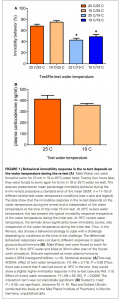The article we have covered in a previous week, “Making Memories of Stressful Events: a journey along epigenetic, gene transcription, and signaling pathways” by Johannes M. H. M. Reul was an article about stressful events having a long lasting impact on both behavior and memories. Basically, we know already that memories are a feature of having a brain. However, due to this feature, between ten to twenty percent of human beings has developed some kind of stress disorder because of at least one traumatic events.The topic today is why people should care about this topic and what the people must know, so without further ado let’s get reading!
The article informs us of an experiment where they took lab mice through an experience where they put the mice in an enclosure which they flooded. Though, the article specifically focuses mainly on reactions between the initial and repeated attempts at this where the mice eventually began to connect the pieces together and began floating naturally. As a result of this connection, we can now classify here that traumatic moments can very much form memories.

Figure one, pictured above, from the article mentioned above is especially excellent at explaining this where it was needed (excellently timed, or in other words placed well). That piece is a bar chart expressing the response of these lab rats upon getting forced to swim for long periods of time. Although, one slight problem could be that it could feel a large bunch overwhelming if you’re not too familiar with the applied terms of figure one in the Neuroscience field. This was an excellent piece to me for it is maximized simplicity because, for clear reasons, that kind of thing strongly helps. The figure may also benefit people uninvolved in Neuroscience as well because figure one uses so much brief, yet descriptive, labeling, and I find that effective myself in general because it’s easy on the eyes to track or logicate.
Now, at this point, one, such as yourself, may wonder why people really should care about all the above information. Well, let’s answer with essential basics to answer ourselves by quickly asking ourselves something simpler first; what really is an anxiety disorder? Well, the answer is absolutely nothing short of a true tragedy. According to Cleveland Clinic, an anxiety disorder is known as “a group of mental health conditions that cause fear, dread and other symptoms that are out of proportion to the situation” (Cleveland Clinic 2025). Considering that we know about these symptoms as a consequence, it’s no shock to pretty much anyone that such a scenario can turn serious fast. Let us put this into perspective with another topic.
In my class, I personally examined the various animal model types used in studies of stress. Surprisingly, I learned from authors at Science Direct of various vertebrate animals, such as animals we often think of as pets (pigs, dogs, rabbits, and so on) used to model the effects stressful events have on the heart muscle (Nicola Maggio and Menahem Segal, 2019). It is nothing short of incredible that we have the option to use inhuman specimens to reduce the need for real human beings in experiments that would be way too dangerous for us all, but I insist that we must subscribe to love and ethics when we do so.
Works Cited:
1) “Making Memories of Stressful Events: a journey along epigenetic, gene transcription, and signaling pathways” by Johannes M. H. M. Reul
2) Cleveland Clinic 2025 on anxiety disorders
3) “Stress, Corticosterone, and Hippocampal Plasticity” by Nicola Maggio and Menahem Segal, 2019